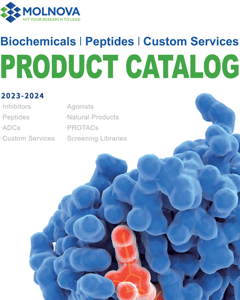
Propiverine hydrochloride
CAS No. 54556-98-8
Propiverine hydrochloride( —— )
Catalog No. M19811 CAS No. 54556-98-8
Propiverine is a widely used antimuscarinic drug with a mixed mode of action in the treatment of symptoms associated with overactive bladder (OAB).
Purity : >98% (HPLC)
 COA
COA
 Datasheet
Datasheet
 HNMR
HNMR
 HPLC
HPLC
 MSDS
MSDS
 Handing Instructions
Handing Instructions
| Size | Price / USD | Stock | Quantity |
| 25MG | 35 | In Stock |


|
| 50MG | 50 | In Stock |


|
| 100MG | 72 | In Stock |


|
| 200MG | Get Quote | In Stock |


|
| 500MG | Get Quote | In Stock |


|
| 1G | Get Quote | In Stock |


|
Biological Information
-
Product NamePropiverine hydrochloride
-
NoteResearch use only, not for human use.
-
Brief DescriptionPropiverine is a widely used antimuscarinic drug with a mixed mode of action in the treatment of symptoms associated with overactive bladder (OAB).
-
DescriptionPropiverine is a widely used antimuscarinic drug with a mixed mode of action in the treatment of symptoms associated with overactive bladder (OAB).(In Vitro):Propiverine (10-3000 nM) inhibits the speci?c binding of [3H]NMS, with Kis of 339, 193 and 497 nM in the bladder, submaxillary gland and heart of mice respectively.(In Vivo):Propiverine (0.5 mg/day; p.o. once daily for 2 weeks) significantly increases UBP and LPP during passive intravesical pressure elevation, and also increases plasma norepinephrine and epinephrine levelsin rats.Propiverine (0.01-1 mg/kg; i.v.) decreases the UBP and totally suppresses the sneeze reflex at the dose of 1 mg/kg in vivo.
-
In VitroPropiverine (10-3000 nM) inhibits the speci?c binding of [3H]NMS, with Kis of 339, 193 and 497 nM in the bladder, submaxillary gland and heart of mice respectively.
-
In VivoPropiverine (0.5 mg/day; p.o. once daily for 2 weeks) significantly increases UBP and LPP during passive intravesical pressure elevation, and also increases plasma norepinephrine and epinephrine levelsin rats.Propiverine (0.01-1 mg/kg; i.v.) decreases the UBP and totally suppresses the sneeze reflex at the dose of 1 mg/kg in vivo. Animal Model:Female adult Sprague-Dawley rats (250-270 g)Dosage:5 mg dissolved in distilled water (0.5 mL)Administration: P.o. once daily for 2 weeks Result:Increased urethral baseline pressure (UBP) and leak-point pressure (LPP) significantly.Increased plasma epinephrine and norepinephrine levels.No significant changes were observed in body weight.
-
Synonyms——
-
PathwayOthers
-
TargetOther Targets
-
RecptorOthers
-
Research AreaNeurological Disease
-
IndicationOveractive bladder; Urinary incontinence
Chemical Information
-
CAS Number54556-98-8
-
Formula Weight403.94
-
Molecular FormulaC23H30ClNO3
-
Purity>98% (HPLC)
-
SolubilityDMSO:198 mM
-
SMILESCl.CCCOC(C(=O)OC1CCN(C)CC1)(c1ccccc1)c1ccccc1
-
Chemical Name——
Shipping & Storage Information
-
Storage(-20℃)
-
ShippingWith Ice Pack
-
Stability≥ 2 years
Reference
1.Ito Y et al. Low Urin Tract Symptoms. 2010 2(1):43-9.
molnova catalog



related products
-
R-IMPP
R-IMPP is an inhibitor of PCSK9 translation. R-IMPP stimulates uptake of LDL-C in hepatoma cells by increasing LDL-R levels, without altering levels of secreted transferrin.
-
Ethopabate
Methyl 4-acetamido-2-ethoxybenzoate is an inhibitor of folate metabolism. It is used as a coccidiostat in poultry.
-
Butyl (E)-2-methylbu...
Butyl (E)-2-methylbut-2-enoate is an aromatic compound found in papaya.



 Cart
Cart
 sales@molnova.com
sales@molnova.com


